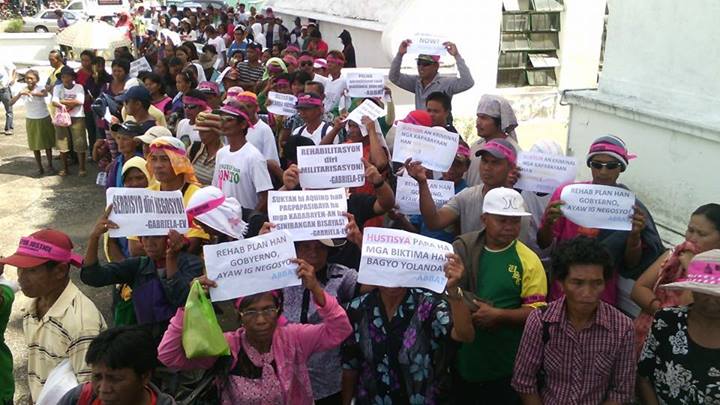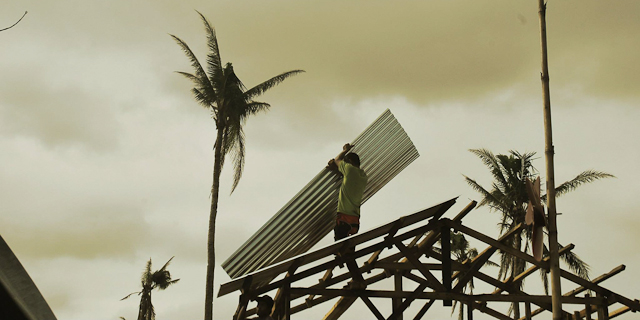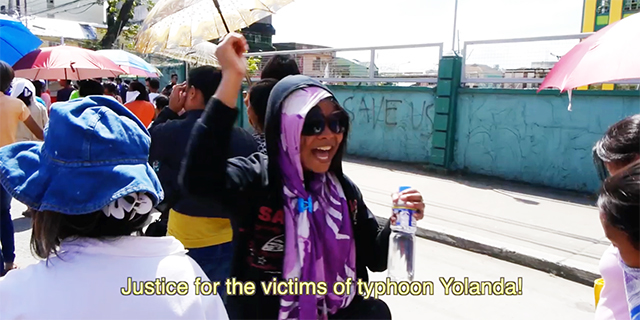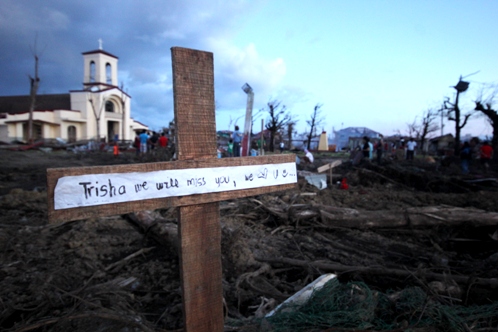Historic ‘surge’: Storm survivors demand justice, relief and rehabilitation
Almost three months after typhoon Yolanda (international name: Haiyan) hit the country, thousands of survivors “surged” through the streets of Tacloban City in the biggest protest that Eastern Visayas has seen in decades. Hailing from remote barrios to coastal villages, an estimated 12,000 people marched around the devastated city last January 25 to seek justice […]
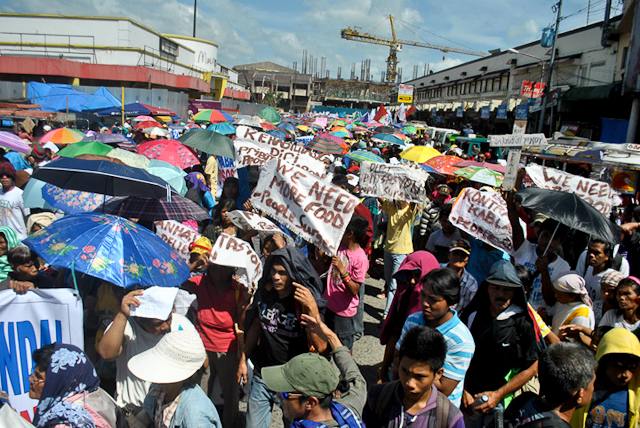

Almost three months after typhoon Yolanda (international name: Haiyan) hit the country, thousands of survivors “surged” through the streets of Tacloban City in the biggest protest that Eastern Visayas has seen in decades.
Hailing from remote barrios to coastal villages, an estimated 12,000 people marched around the devastated city last January 25 to seek justice for the Aquino administration’s “criminal negligence” and to lay down demands to the government for their relief and rehabilitation.
Homeless, hungry, and without livelihood, the survivors led by a newly-formed alliance People Surge (Alliance for the Victims of Typhoon Yolanda) are seeking for P40,000 financial relief for each family, housing, jobs and livelihood assistance, price controls, speedy rehabilitation of hospitals and schools, and restoration of water and electricity.
‘Proof of discontent’
The survivors mostly came from Tacloban and Ormoc City, Tanauan, Palo, and Carigara in Leyte; and Basey, Calbiga, Pinabacdao, Hinabangan, and Sta. Rita in Samar. Most of them were farmers and fisher folk who traveled or walked for hours.
Estelita Ragmac, 64, said that her family fled to Manila in December because relief came only twice in her village Bulaw in Basey, Samar. They came back a week ago to try to start anew. “It has been difficult. We still have no crops, nothing to eat. I came to this protest to ask for the government’s help,” she said.

People Surge assailed President Aquino’s slow-to-non-existent relief and rehabilitation efforts, corruption of aid, and the implementation of “pro-big business” policies such as the No-Build Zone.
“The massive number of people (who marched) is proof of their intense discontent over Aquino’s criminal negligence and utter incompetence in looking after the welfare of its people,” said Sr. Edita Eslopor, OSB, chairperson of People Surge.
Latest estimates from the National Disaster and Risk Reduction Management Council (NDRRMC) reveal Yolanda’s damages in infrastructure amounted to P18.3 Billion, and damages in agriculture amounted to P18.4-B in affected areas.
The official NDRRMC death toll is currently at 6,201, though thousands remain missing and more bodies are being collected each day.
No homes, livelihoods
Storm survivors say that relief mostly comes from international organizations and private institutions.

“Before the storm hit, President Aquino promised that the government was prepared, but relief was slow, inadequate, and disorganized. He must be held liable for his negligence,” said Dr. Efleda Bautista, a retired teacher and executive vice-chairperson of People Surge.
Peasant groups who joined the alliance say that relief does not come at all for farmers in far-flung areas that are equally devastated.
“Even before Yolanda, majority of landless farmers in Leyte and Samar are already poor. But our situation worsened after the storm,” said Nestor Lebico, secretary-general of the peasant group Sagupa-Sinirangang Bisaya.
Gorgonio Advincula of New San Agustin, Basey, Samar said that the storm washed out his home, crops, carabao, and fishing boat. “With no coconut trees and rice to depend on, we have nothing to eat,” he said.
Another farmer, Lilio Obira, said, “We received relief goods only once. We have no shelter from the heat and cold. My children right now are just staying under a tree.”
Despite the extensive damage to agriculture, farmers have not received any livelihood assistance, according to Sagupa.
While the Department of Agriculture gave out seeds in some areas, “farmers couldn’t plant these seeds because they were high-yielding varieties and needed costly farm inputs,” Lebico revealed.
For the protest, the survivors in coastal areas of Tacloban City carried placards made out of rice sacks that read “No-Build Zone, Anti-People”. They are opposed to the government’s prohibition of the construction of homes within 40 meters of the shoreline.

Marco Ragrag of Brgy. 37 said that they are now being prevented to return along the shoreline. Most of them live either in makeshift tents along the sidewalks or in jeepney terminals. “We need a decent place to stay and construction materials for a home,” he said.
Joel Reyes, a member of Alyansa han mga Biktima han Bagyo Yolanda ha Tacloban or Alliance of Typhoon Yolanda Victims in Tacloban (ABBAT), said that they have nowhere else to go. “Most of us make a living as fishermen. Why doesn’t the government build a strong seawall to protect us, or devise an evacuation system instead?” he said.
Many lost their boats and fishing equipment, and could hardly survive, Reyes added.
He further complained that prices have been skyrocketing in Tacloban. “The prices were low only in the beginning. Now, one kilo of rice can cost up to P70,” he said.
Most residents of Tacloban City are now without jobs, as most establishments remain closed and electricity and water services have yet to be restored to the entire city.
“Without the government providing housing and livelihood, the ‘No-Build Zone’ only serves the interests of big businesses who are interested in land grabbing,” said Paul Isalona, chairperson of Bayan-Tacloban.
He said that the victims, and not big businesses, should be at the core of the relief, rehabilitation and reconstruction efforts of the government.

Other demands
Meanwhile, Bautista said that President Aquino should heed the survivors’ demand–or else face calls for his ouster. “This protest belies the recent SWS survey that rated the Aquino administration ‘very good’ in delivering relief and rehabilitation for typhoon victims,” he said.
Before the protest, the survivors gathered at the Eastern Visayas State University for the People Surge assembly. The alliance is composed of survivors as well as volunteers from the religious sector, academe, professionals, lawyers, and small entrepreneurs.
Among those who attended the assembly were progressive lawmakers Carlos Zarate of Bayan Muna and Fernando Hicap of Anakpawis, Renato Reyes of Bagong Alyansang Makabayan, and Dr. Delen de la Paz of Council for Health and Development.
“People Surge believes that natural disasters may be inevitable, but people’s lives can be spared and massive damage may be prevented or minimized if the government takes adequate preparedness and prompt action in the face of natural calamities,” the alliance said.
Other demands include a one-year tax moratorium to help local businesses and small entrepreneurs and public consultations in crafting rehabilitation and reconstruction plans to ensure that victims, “not the big businesses and landlords,” are at the core of such plans.
The alliance is also pushing for long-term demands. These include a review of environmentally-destructive policies such as mining and laws on disaster risk preparedness and response, as well as genuine agrarian reform and a national industrialization program “as a key solution to mass poverty and its consequent people’s vulnerability to disasters and climate change impacts.”
Report by Ilang-Ilang Quijano and Macky Macaspac
More photos:






